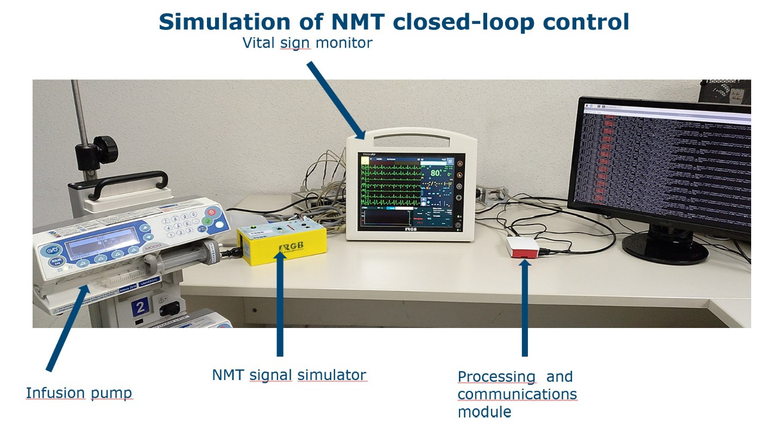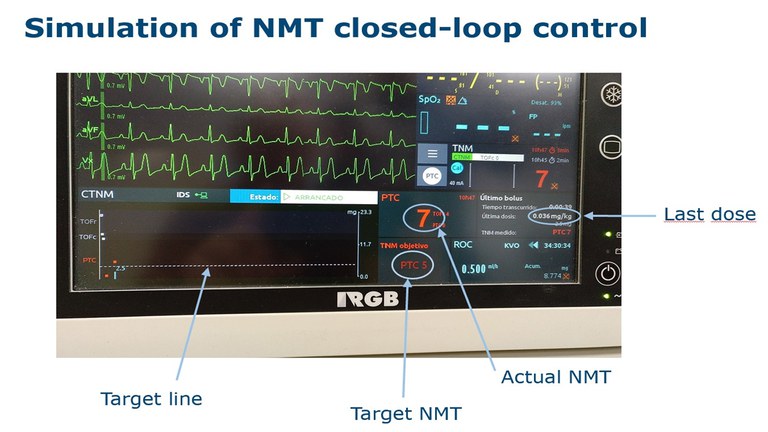NMT Infusion Controller
Some
PATIENT SIMULATIONS
In order to verify the correct behavior of the simulator, the simulator has been run with different patient configurations. In these tests, an initial dose of relaxant has been applied to the patient and has been allowed to evolve (without applying additional doses) until complete recovery.
The tests have been carried out in series where a single parameter of the simulation is varied, in order to verify that the effects of said parameter are consistent with clinical experience.
Volume of Distribution (Vd)
When the drug is injected into the patient, it is dispersed in a volume known as the “volume of distribution” and is expressed in ml/kg.
In the following graphs we see how both the concentration of the drug in plasma (CP) and the neuromuscular transmission (NMT) evolve depending on the different Vd of the patient.
We can see how as Vd increases the concentration of the drug in the plasma decreases. Logically, its concentration is lower as the volume where the drug is distributed is greater.
The behavior of the NMT recovery is also logical. As Vd increases (and therefore Cp decreases) the time over which the drug takes effect decreases.
Plasma Concentration Cp50
Cp50 is the plasma concentration which would, at steady state, produce 50% depression of NMT response. This means that the lower the Cp50, the more sensitive the patient is to the drug.
In the following graph we see how neuromuscular transmission (NMT) evolves depending on the different Cp50 of the patient.
In the graph, it can be seen that the recovery time increases with a lower Cp50. This is consistent with the actual behavior of patients, since the patient who is more sensitive to the drug (<Cp50) needs less drug plasma concentration to have the same effect on NMT and therefore takes longer to recover the NMT.
Initial Dose
In the following graphs we see how both the plasma drug concentration (CP) and the neuromuscular transmission (NMT) evolve as a function of different initial drug doses.
The higher the dose, the higher the concentration in plasma and therefore the longer the drug remains in the patient, prolonging his recovery.
NMT CONTROL (STRATEGY CONTROL ALGORITHM 1
Once the correct operation of the patient simulator has been verified, we will apply it to evaluate Dr. Biro's NMT control strategy.
In order to assess the effectiveness of the strategy, several controls are performed by varying the patient's parameters of Vd and Cp50. The following graphs show the results obtained.
|
|
Tabla 1. Control data with control algorithm 1
|
|
|
Target PTC
|
Media PTC
|
(sd)
|
PTC Above (%)
|
PTC Below (%)
|
PTC Target (%)
|
|
Vd = 20 ml/kg
|
4
|
3.94
|
1.4
|
31
|
48
|
21
|
|
Vd = 38 ml/kg (*)
|
4
|
4.5
|
1.05
|
45
|
25
|
30
|
|
Vd = 70 ml/kg
|
4
|
5.53
|
1.46
|
71
|
3
|
26
|
|
Cp50 = 0.6 µg/mL
|
4
|
4.22
|
1.56
|
41
|
42
|
17
|
|
Cp50 = 0.8 µg/mL (*)
|
4
|
4.5
|
1.05
|
45
|
25
|
30
|
|
Cp50 = 1.3 µg/mL
|
4
|
5.25
|
1.15
|
67
|
8
|
25
|
|
|
|
|
|
|
|
|
(*) Are the same control.
With this control algorithm, the control strategy is best achieved when the patient's configuration matches standard values (Vd = 38 mL/kg, Cp50 = 0.8 µg/mL). In this case, the standard deviation is the lowest (1.05) and the time spent on target is also the highest (30%).
When the patient's configuration is not very sensitive to the drug (high Vd or high Cp50), then the dose applied by this strategy is insufficient and the NMT value remains above the target for a long time (71% and 67%).
When the patient's configuration is very sensitive to the drug (low Cp50) then the dose applied by this strategy causes large variations in the NMT value (its standard deviation is very large 1.56).


